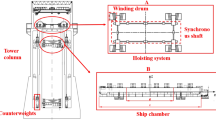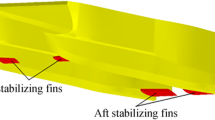Abstract
To achieve energy conservation and improve ship maneuverability, a new type of collaborative spoiled rudder (CSR) is proposed by absorbing the advantages of existing ship rudders. This study investigates the non-stationary characteristics of the hydrodynamic forces of CSR section in depth, and carries out structural optimization based on numerical simulations. First, the effects of rudder angle and spoiler open angles on the non-stationary characteristics of the hydrodynamic forces of the CSR, and the appropriate maximum value of the spoiler open angle is determined. The results show that the unsteady pulsation amplitude of the hydrodynamic forces of the CSR is directly proportional to the spoiler open angle and inversely proportional to the rudder angle, and the upper limit of the spoiler open angle is set to 30°. Then, the hydrodynamic characteristics of the CSR with different spoiler widths are investigated in further. The maximum lift of the CSR increases as the spoiler width increases. The target lift method is used for efficiency evaluation. The ranges of the favorable rudder angle and the favorable spoiler open angle for different CSR configurations are determined, and the optimal spoiler width is further determined based on the non-stationary characteristics of the hydrodynamic forces.



























Similar content being viewed by others
References
Zaman I, Pazouki K, Norman R, Younessi S, Coleman S (2017) Challenges and opportunities of big data analytics for upcoming regulations and future transformation of the shipping industry. Proc Eng 194:537–544
Sasaki N, Kuribayashi S, Atlar M (2018) Gate rudder. In: The 3rd international symposium on naval architecture and maritime (INT-NAM), Istanbul, pp 89–108
Li F, Hu HB, Li BH, Jiang SH (2020) Current development and technology status of high performance rudders. Chin J Ship Res 15(3):61–74
Hou LX, Yang J, Hu AK, Chang X, Lin Y, Yin LL, Chuang ZJ (2022) Hydrodynamic characteristic investigations of a collaborative spoiled rudder under open water conditions. Ocean Eng 253:111251
Hou LX, Lin Y, Yang J, Hu AK, Chang X (2022) Cooperative drive control unit of spoiled rudder. CN Patent 115675816A
Hou LX, Lin Y, Zhu JQ, Wang QC, Yang J, Liang HF, Chang X (2023) Two-dimensional study on the hydrodynamic performance of collaborative spoiled rudder. Ocean Eng 271:113826
Molland AF, Turnock SR (1991) Wind tunnel investigation of the influence of propeller loading on ship rudder performance. Technical Report. Ship Science Report No. 46, University of Southampton, Southampton
Vantorre M (2001) Stationary and non-stationary open water rudder tests. In: Kijima K (ed) Mini symposium on prediction of ship manoeuvring performance, Tokyo, pp 103–111
Ahn KS, Choi GH, Son DI, Rhee KP (2012) Hydrodynamic characteristics of X-twisted rudder for large container carriers. Int J Nav Archit Ocean Eng 4(3):322–334
Paik BG, Ahn JW, Jeong H, Seol H, Song JY, Ko YH (2021) An experimental study on the frequency characteristics of cloud cavitation on naval ship rudder. J Soc Nav Archit Korea 58(3):167–174
Nguyen TV, Ikeda Y (2014) Development of fishtail rudder sections with higher maximum lift coefficients. In: Proceedings of the 24th international ocean and polar engineering conference, Busan
Liu JL, Quadvlieg F, Hekkenberg R (2016) Impacts of the rudder profile on manoeuvring performance of ships. Ocean Eng 124:226–240
Yang Y, Wang ZL, Geng JM (2020) Numerical Study on the flap rudder hydrodynamic simulation based on CFD. Ship Sci Technol 42(4):46–50
Ibraheem A (2021) Evaluating the efficiency of polyhedral mesh elements in solving the problem of the flow around ship’s rudder. Int J Eng Manag Sci 6(2):1–19
Kim HJ, Kim SH, Oh JK, Seo DW (2012) A proposal on standard rudder device design procedure by investigation of rudder design process at major Korean shipyards. J Mar Sci Technol (Taiwan) 20(4):450–458
Liu JL (2020) Mathematical modeling of inland vessel maneuverability considering rudder hydrodynamics. Springer, Cham
Eleni DC, Athanasios TI, Dionissios MP (2012) Evaluation of the turbulence models for the simulation of the flow over a national advisory committee for aeronautics (NACA) 0012 airfoil. J Mech Eng Res 4(3):100–111
Menter FR (1994) Two-equation eddy-viscosity turbulence modeling for engineering applications. AIAA J 32(8):1598–1605
Schatzman M (2002) Numerical analysis, a mathematical introduction. Oxford Univ Pr., Oxford
Stern F, Wilson RV, Coleman HW, Paterson EG (1999) Verification and validation of CFD simulations. Iowa Institute of Hydraulic Research, University of Iowa, IIHR Report No. 407
Ladson CL (1988) Effects of independent variation of mach and reynolds numbers on the low-speed aerodynamic characteristics of the NACA 0012 airfoil section. Technical report, Langley Research Center, Hampton
Acknowledgements
This research is financially supported by the Liaoning Provincial Natural Science Foundation of China (Grant No. LJKMZ20220367) and the Fundamental Research Funds for the Central Universities (3132023121).
Author information
Authors and Affiliations
Corresponding author
Additional information
Publisher's Note
Springer Nature remains neutral with regard to jurisdictional claims in published maps and institutional affiliations.
Appendix
Appendix
Mesh uncertainty analysis about the NACA0012 section was carried out, and the results (lift and drag coefficients) were compared with the corresponding experimental data to validate the mesh generating strategy and numerical method.
The three-mesh estimate method was adopted for the mesh uncertainty analysis, and three meshes (coarse mesh G01, median mesh G02 and fine mesh G03) were produced with the refinement factor of \(\sqrt 2\). The CL and CD values were used as variables. G01 and G03 were obtained by increasing or decreasing the grid size by a factor of \(\sqrt 2\) globally based on G02. The grid size of the median mesh G02 was dynamically adjusted until the results did not change significantly with a finer mesh.
Table 4 presented the final results of the mesh uncertainty analysis. The specific calculations of the parameters given in Table 4 were based on the work of Stern et al. [20]. For the median mesh G02, the chord-spacing of the mesh along with the section was 1.5 × 10–3 C, and the layer-wise growth rate of the boundary layer was 1.1, as proposed by Liu et al. [16]. The first layer thickness of the medium mesh was set to 2.2 × 10–6 C, corresponding to a y+ of 0.5. A y+ of this size could be sufficient to properly resolve the inner parts of the boundary layer. The coarse G01, median G02, and fine G03 meshes had 0.98 × 105, 1.4 × 105 and 2.1 × 105 cells, respectively. The corresponding time step for different mesh structures was determined under the condition that the target max CFL was 5.0 and the mean value was 0.5. The results demonstrated that the hydrodynamic forces decreased with the increase in cell number under a monotonic convergence with a convergence ratio 0 < RG < 1. This indicated that the impact of the mesh change was accepted to be small between G02 and G03. Besides, the reasonable small levels of the mesh uncertainty (\({\text{U}}_{\text{G}}\)) for the fine mesh set G01 were estimated. The results demonstrated that the satisfactory mesh uncertainties were obtained.
Table 5 showed the lift and drag coefficients of median mesh G02 and the corresponding experimental data [21]. The simulated results exhibited a good agreement with the experimental data.
About this article
Cite this article
Hou, L., Zhu, J., Wang, Q. et al. Non-stationary characteristics and structural optimization of CSR section under open-water condition. J Mar Sci Technol (2024). https://doi.org/10.1007/s00773-024-00991-8
Received:
Accepted:
Published:
DOI: https://doi.org/10.1007/s00773-024-00991-8




